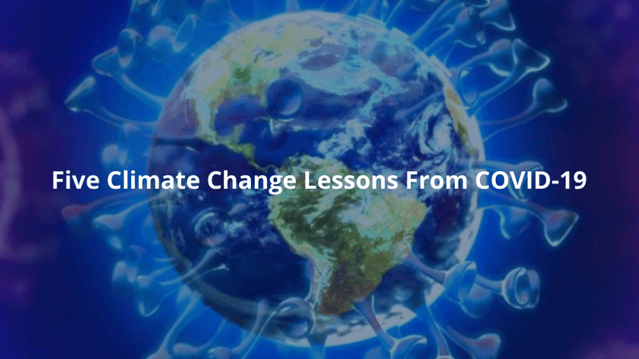
Editor’s Preface: Paola Massoli has been working as a research analyst on our advocacy team. Paola has a PhD In Atmospheric Science and is finishing up a master’s degree in Sustainability & Environment. Recently she has been thinking about lessons we might be able to learn from COVID-19 that could prepare us better to tackle the climate crisis.
For a few weeks, many of us working on energy and climate felt less comfortable talking about the climate crisis because of the suffering and disruption brought by COVID-19. However, despite the virus, global warming marches on, which means that we still need to talk about it and, more importantly, act with urgency. As we searched for whether there is something to be learned from the current times, we found several parallels with the climate crisis and five lessons that COVID-19 can teach us.
Related webinar May 28th at noon: Clean energy policies we need now in MA & RI
Lesson #1 – Science Matters
COVID-19 is showing us the importance of trusting the experts. When it comes to both human health and climate change, personal opinions and political beliefs are secondary to data and science. Unfortunately, objective truths sometimes are tough to deal with. But there is a positive flip side: science offers solutions. In the case of COVID-19, we know that social distancing works in absence of a vaccine; in the case of climate change, we know that improving energy efficiency and transforming our energy systems away from fossil fuels is paramount. When it comes to the pandemic, most Americans are paying close attention to doctors because our lives depend on them. Similarly, most people by now accept the international scientific consensus around climate change. But despite that recognition, actions have not been commensurate to the climate challenge, for reasons that have little to do with science.
COVID-19 is also teaching us that nations, states, and cities that tackle a problem guided by science have a better chance to succeed. The ones letting denial and panic take over tend to squander their response, end up less prepared and make matters worse. The same is and will be increasingly true when it comes to climate change.
Lesson #2 – The Risks in Neglecting Low Probability & High Impact Phenomena
One of the factors that shocked the world is how easily COVID-19 spread from one continent to another. The World Health Organization (WHO) knew about this virus in December of 2019 (that’s why it is called COVID-19), told us about the virus having ‘pandemic potential’ at the end of January 2020, and by the time a global pandemic was declared in mid-March, it was too late. In an eerily similar fashion, climate scientists have sounded alarms about global warming for decades. James Hansen's testimony to Congress in 1988 is probably the epitome of alarm sounding, but many warnings were given before 1988 and certainly after.
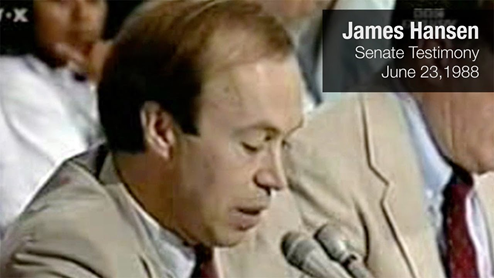
Waiting to act comes with a price tag. Every year since 1980, the National Climatic Data Center (NCDC) of the National Oceanic and Atmospheric Administration has been tallying the number of billion-dollar disaster events across the United States. In 2019, there were 14 of such disasters, up 5 times from 20 years ago. The total cost over the last 3 years (2017-2019) exceeds $460.0 billion — averaging $153.4 billion/year (and this tally does not consider the ‘smaller’ disasters that cost less than one billion each, which have also increased). While the NCDC clarifies that number and cost of disasters are going up over time due to a combination of factors, the agency also says that ‘climate change is increasing the frequency of some types of extremes that lead to billion-dollar disasters.’ We already crossed several thresholds, and that requires a different kind of preparation and resilience.
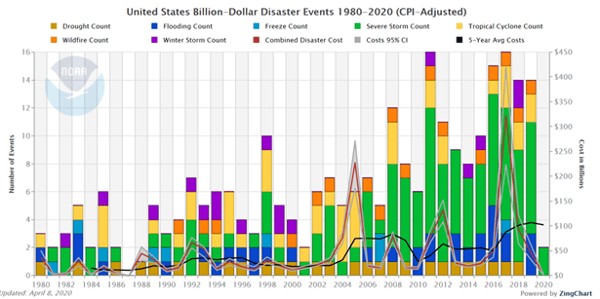
Histogram of the number of the U.S. billion-dollar disaster events and associated costs occurred since 1980. Since 2005, the number of severe storms (green bar) has gone up threefold, exactly like climate scientists had predicted. Image Source.
Lesson #3 – We Need to Build Global Resilience
We, as global society, are not prepared to address disruptive events through effective resilience mechanisms that would allow us to bounce back in a reasonable time. We generally know what is needed to address and solve problems, but we lack strategies because, as lesson #2 taught us, we tend not to prepare for what we believe are low probability & high-risk events. The lack of protective protection equipment (PPE) is a clear example of how unprepared we were (in some nations more than others) when COVID-19 emerged.
When it comes to climate change, the story is no different. Island and developing nations — even though they have contributed the least to global carbon emissions to date — are the most vulnerable to extreme events and unable to sustain disruption. In the U.S., the cities most vulnerable to climate change related disasters — heat waves, flooding, rising seas, drought — are also the least prepared. COVID-19 is reminding us that we are only as strong as our weakest link in the chain, and that we need economic welfare, mobility, and infrastructure resilience for everyone to thrive as a society. This is a solidarity lesson that directly applies to climate change.
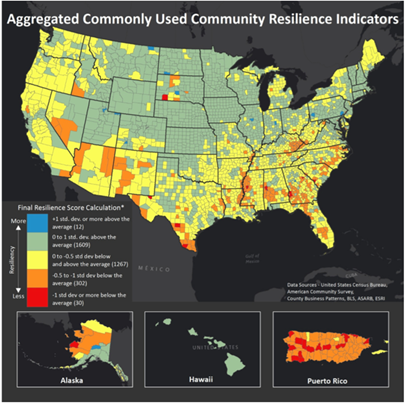
Community Resilience Indicator Analysis: County-Level Analysis (Argonne National Laboratory). Image Source.
Lesson #4 – Inequality is Severe
COVID-19 is wreaking havoc on everyone, but it has hit specific segments of society harder than others: the front-line workers — bus drivers, grocery clerks, cleaning crews, warehouse and food processing workers — the majority of whom are African-American, Latino, and working-class white. It has been well reported that disadvantaged people, such as those with no health insurance and poorly managed health conditions, are more susceptible to contract the virus and die from it, as pointed out recently in the Journal of the American Medical Association. We know that economic, health, and social inequalities have existed for a long time and permeate every aspect of life, even when it comes to riding public transit.
You probably see the parallel with climate change too: the five U.S. cities at the bottom of the rankings for climate readiness mentioned in the previous section have the largest African American and Latino populations. These populations are also the ones more chronically exposed to pollution from traffic and industrial emissions that also increase the risk of respiratory and cardiovascular illness and therefore worsens the outcomes of COVID-19.
The pandemic has exposed and amplified an array of old and systemic problems that ultimately affect all of us. COVID-19 is showing that we need to attack the climate problem not just scientifically, but from a socioeconomic standpoint as well, with equity at the forefront.
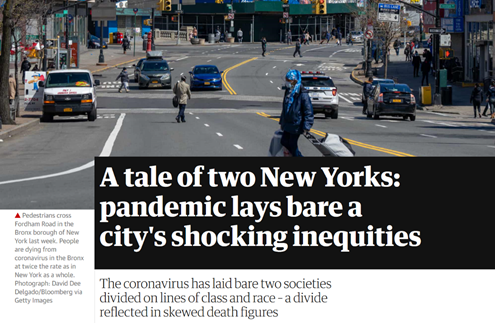
COVID-19 has revealed and worsened inequalities that have plagued many communities across America. Image Source.
Lesson #5 – Dealing with Global Issues Requires Governmental Action
At Green Energy Consumers Alliance, we believe in the power of consumers to make a difference by adopting clean energy choices and sustainable behaviors when possible. However, the power of individuals is limited when it comes to global challenges. COVID-19 has shown us that in times of global crisis, government action matters and inaction kills. The same lesson applies to climate change. Without nationwide carbon emission reduction and environmental protections and standards, mayors and governors can only mitigate so much. Systemic problems require systemic solutions and adequate federal funding to be directed to the programs that can build a cleaner and more resilient future.
A Green New Day?
In the last two months, countless articles, opinion pieces and webinars have illustrated with varying degree of detail how the more advanced economies could ‘build back better’ by adopting green stimulus packages. The rationale is that a ‘green new deal’ would provide millions of jobs in key infrastructure sectors while avoiding further significant fossil fuel burning that would deal the final blow to the fight against climate change. Investing in clean energy makes sense because solar and onshore wind are the cheapest sources of power in most of the world, battery prices are dropping, and any electric vehicle is on average 50% cleaner than its combustion engine counterpart pretty much everywhere. Plus, we have public transit projects to work on, millions of buildings to insulate and retrofit, an agricultural sector to re-invent and a waste sector to repurpose. We know what to do to slash carbon emissions from every sector of the economy. But we need money, laborpower, and political will.
A few days ago, the International Energy Agency stated that ‘renewables are set to be the only energy source that will grow in 2020.’ If COVID-19 teaches us anything at all, we should not go back to burning fossil fuels as usual, which is also what the scientific consensus around climate change has been recommending for a long time. Perhaps it is time to listen to those scientists and flatten the curve on climate change as well.





Comments